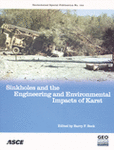Characterization of a Sinkhole Prone Retention Pond Using Multiple Geophysical Surveys and Closely Spaced Borings
Publication: Sinkholes and the Engineering and Environmental Impacts of Karst
Abstract
Sinkholes are one of the well known geological hazards in the state of Florida. In Alachua County Florida, sinkholes have become problematic in highway retention ponds, especially along State Road 26 west of I-75. As part of a Florida Department of Transportation effort to minimize the effects of sinkholes in retention ponds, multiple geophysical surveys and closely spaced boring were used to characterize a retention pond that had experienced previous sinkhole activity. Within the approximately 0.6 hectare retention pond, a survey grid consisting of lines and stations, both with 1.52 meter spacing was established. One of the survey lines was aligned with 12 geotechnical borings that were previously conducted to establish the site stratigraphy. The borings were placed approximately 3 to 7.6 meters apart. The depth of the borings ranged between approximately 9 to 12 meters. Five different geophysical techniques, ground penetrating radar (GPR), electrical resistivity (ER), gravity survey, multielectrode resistivity (MER), and capacitively coupled resistivity (CCR) were used to characterize the subsurface stratigraphy in the vicinity of the borings. As expected in a karst region, the stratigraphy determined from the closely spaced borings was very erratic; the limestone bedrock surface varied between depths ranging from the ground surface to greater than 9 meters, within a lateral distance of 15 meters. Open voids within the limestone, one over 6 meters in length, were also detected in the borings. The results of the geophysical surveys compared favorably with the stratigraphy determined through borings, and multiple geophysical techniques were able to detect anomalies in the same vicinity at the same depths. Based on the work conducted at this site, both traditional intrusive exploration techniques and geophysical surveys were required to fully characterize the subsurface. Two recommendations for retention pond site characterization were derived from this work: geotechnical borings must be conducted to determine depth of bedrock, and at least two geophysical methods measuring different subsurface properties and have approximately the same depth of investigation with the depth of investigation being at minimum the soil/bedrock interface.
Get full access to this chapter
View all available purchase options and get full access to this chapter.
Information & Authors
Information
Published In
Copyright
© 2005 American Society of Civil Engineers.
History
Published online: Apr 26, 2012
Authors
Metrics & Citations
Metrics
Citations
Download citation
If you have the appropriate software installed, you can download article citation data to the citation manager of your choice. Simply select your manager software from the list below and click Download.
